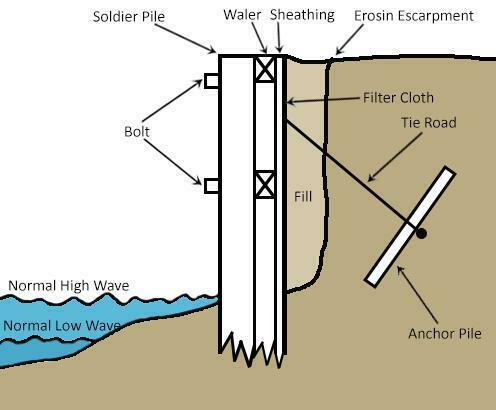What is Bulkhead Wall in Construction?
A bulkhead is a sort of retaining wall that holds soil in place while offering only modest protection from sea waves, helping to provide stability or minimize beach erosion. These should be planned and built in a way that they can withstand the erosion brought on by the powerful sea waves as they are often smaller and broader than seawalls. Bulkheads may also be utilized in mines to limit flooding to a specific area. Wood pilings, commercial vinyl goods, sizable rocks, and any other sturdy, hard material that may be utilized to build a bulkhead are acceptable materials for the bulkheads.
Another type of bulkhead wall in construction is an anchor bulkhead. The tie or anchor rods are buried in the backfill rather far from the back of the wall. The ties or attached rods limit lateral deflection, bending moment, and penetration depth. Anchored bulkheads are common in waterfront constructions.
Functional Characteristics of Bulkhead Wall
- The primary function of a bulkhead is to slow erosion on a bluff or beachfront.
- It acts as a coast protection structure.
- It also protects land movement and damage to sloped areas of land from changes in ground conditions.
- A bulkhead’s role in a protected environment is to hold or prevent land sliding at the transition between filled or natural land and the sea.
- Bulkhead wall in construction function well as a separation between land and sea in marina basins and along protected shorelines.
- A typical design of a bulkhead is shown in the figure below.

Difference between Bulkhead Wall and Retaining Wall
Bulkhead Wall
- 1. The bulkhead wall is surrounded on one side by the soil and the other side by water.
- 2. They are built on shorelines to help prevent beach erosion of shorelines and retain soil.
- 3. They are built parallel to and close to high water marks to protect them from ocean currents, and waves(moderate), and to prevent land movement.
- 4. Bulkhead walls are useful in coastal areas.
- 5. Bulkhead walls may not be the permanent solution in some areas, but in some areas, they can be explored as a permanent solution.
- 6. Vinyl bulkhead walls have a service life of 50 years or more.
Retaining Walls
- A retaining wall is an inflexible and highly durable structure that retains the soil on both sides of the wall.
- The primary function of a retaining wall is to prevent land movement, such as sliding.
- Retaining walls can be constructed with concrete, steel, vinyl, rock, etc.
- Retaining walls can be used in many other areas.
- Retaining walls can be a permanent solution for an area, but their life also depends on the material used for the construction.
Disadvantage of Bulkhead
The most serious issue with bulkhead systems is the erosion of the backfill area. The granular surface and drainage are both compromised when the backfill begins to deteriorate. The rise in hydrostatic pressure, along with the lateral pressures of the ground, causes the units to tip over.











